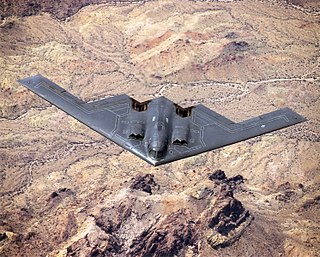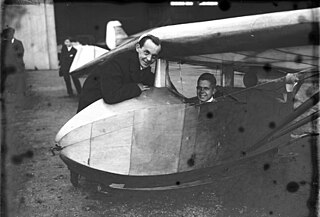Related Research Articles

A fixed-wing aircraft is a heavier-than-air flying machine, such as an airplane, which is capable of flight using wings that generate lift caused by the aircraft's forward airspeed and the shape of the wings. Fixed-wing aircraft are distinct from rotary-wing aircraft, and ornithopters. The wings of a fixed-wing aircraft are not necessarily rigid; kites, hang gliders, variable-sweep wing aircraft and airplanes that use wing morphing are all examples of fixed-wing aircraft.

A flying wing is a tailless fixed-wing aircraft that has no definite fuselage, with its crew, payload, fuel, and equipment housed inside the main wing structure. A flying wing may have various small protuberances such as pods, nacelles, blisters, booms, or vertical stabilizers.

Wilhelm Emil "Willy" Messerschmitt was a German aircraft designer and manufacturer. In 1934, in collaboration with Walter Rethel, he designed the Messerschmitt Bf 109, which became the most important fighter aircraft in the Luftwaffe as Germany rearmed prior to World War II. It remains the second most-produced warplane in history, with some 34,000 built, behind the Soviet Ilyushin Il-2. Another Messerschmitt aircraft, first called "Bf 109R", purpose-built for record setting, but later redesignated Messerschmitt Me 209, broke the absolute world airspeed record and held the world speed record for propeller-driven aircraft until 1969. Messerschmitt's firm also produced the first jet-powered fighter to enter service — the Messerschmitt Me 262.

Alexander Martin Lippisch was a German aeronautical engineer, a pioneer of aerodynamics who made important contributions to the understanding of tailless aircraft, delta wings and the ground effect, and also worked in the U.S. Within the Opel-RAK program, he was the designer of the world's first rocket-powered glider.

The DFS 194 was a rocket-powered aircraft designed by Alexander Lippisch at the Deutsche Forschungsanstalt für Segelflug.

The empennage, also known as the tail or tail assembly, is a structure at the rear of an aircraft that provides stability during flight, in a way similar to the feathers on an arrow. The term derives from the French language verb empenner which means "to feather an arrow". Most aircraft feature an empennage incorporating vertical and horizontal stabilising surfaces which stabilise the flight dynamics of yaw and pitch, as well as housing control surfaces.
The Société des Ateliers d'Aviation Louis Bréguet also known as Bréguet Aviation was a French aircraft manufacturer.

The Baynes Bat was an experimental glider of the Second World War, designed by L. E. Baynes. It was used to test the tailless design that he had suggested as a means to convert tanks into temporary gliders so they could be flown into battle.

The General Aircraft GAL.56 was a family of 1940s British experimental tailless swept wing glider designs.

The Fauvel AV.36 was a single-seat tailless glider designed in France in the 1950s by Charles Fauvel. Although the "AV" in AV.36 stands for Aile Volante, it was not a true flying wing: it featured two large fins mounted on stubby tailbooms extending back from the wing's trailing edge, and accommodated the pilot within a stubby fuselage. The aircraft was designed to be quickly disassembled for road transport, with the nose detaching, and the fins able to fold back against the trailing edge of the wing. A refined version with a slightly longer wingspan, the AV.361 was introduced in 1960.

A glider is a fixed-wing aircraft that is supported in flight by the dynamic reaction of the air against its lifting surfaces, and whose free flight does not depend on an engine. Most gliders do not have an engine, although motor-gliders have small engines for extending their flight when necessary by sustaining the altitude with some being powerful enough to take off by self-launch.

A tailless aircraft has no other horizontal aerodynamic surface besides its main wing. It may still have a fuselage, vertical tail fin and/or vertical rudder.
The Fauvel AV.44 was a design for an unorthodox light aircraft produced in France in the 1970s. The work of Charles Fauvel, it was based on his pre-war AV.10 and like it, was a tailless monoplane with a reverse-delta planform and side-by-side seating in an enclosed cabin. The AV.44 featured considerably more modern aerodynamics and accommodation for two passengers in place of the AV.10's one. Five examples were under construction in 1977.
The Fauvel AV.50 Lutin was a design for an unorthodox light aircraft produced in France in the 1970s. Like some other Charles Fauvel designs, it was a tailless aircraft with a reverse-delta wing. In this case, it was a single-seater intended to be powered by a converted Volkswagen engine. Only one example was known to have been under construction by 1977, in Australia.
The Fauvel AV.45 was an unorthodox motor glider produced in France in the 1960s and 1970s. Like other Charles Fauvel designs, it was a tailless aircraft, in this case inspired by the work that German firms had done on producing motorised versions of his AV.36 design. The prototype of the AV.45 was an extensively modified AV.36 powered by a Nelson H-59 two-stroke engine. AV.45s have been built with a number of other engines, however, including at least one aircraft powered by a small turbojet. Falconar marketed the plans in the 1970s.

The Fauvel AV.22 was an unorthodox glider produced in France in the 1950s, 60s, and 70s. Originally intended to be produced in series, it was later marketed to homebuilders. Like other Charles Fauvel designs, it was a tailless aircraft, and this particular design featured wings with a slight forward sweep.

The Marske XM-1 was an American mid-wing, single-seat, experimental tailless glider that was designed and built by Jim Marske in 1957.

The Fauvel AV.10 was a tailless light aircraft built in France by Charles Fauvel. A two-seater side-by-side and equipped with a 75 hp engine, it first flew in 1935. Designed by Charles Fauvel, it was his first powered aircraft, designed from the outset as that, to have been realised. In 1936, it had been exhibited at the 25th Salon de L'Aéronautique at the Grand-Palais of Paris. The AV-10 was a one-off design and disappeared in 1940, when it's believed it was taken by German troops.
The Fauvel AV.31 was a design for a French flying wing airliner conceived by Charles Fauvel in the early 1940s.
References
| Wikimedia Commons has media related to Charles Fauvel . |
- ↑ "Charles Fauvel and his flying wings". www.nurflugel.com. Retrieved 2022-06-10.
- ↑ « Un aviateur angevin : Charles Fauvel », Les Cahiers du RSA, no 168, septembre-octobre 1989